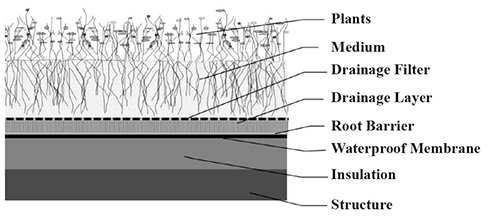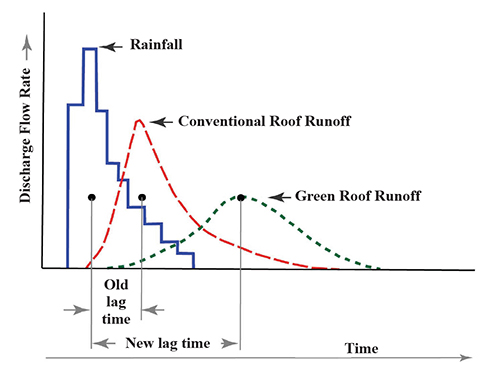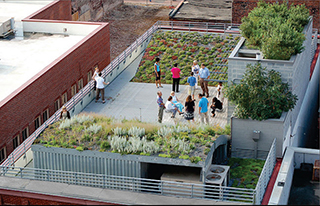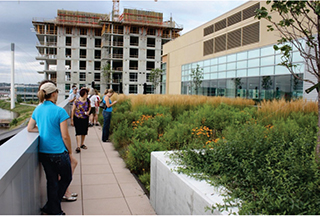G2244
Stormwater Management:
Green Roof Basics
This NebGuide provides basic information on the history, design, construction, maintenance, and benefits of green roofs as a stormwater best management practice.
Richard K. Sutton, Professor, Landscape Architect
Steven N. Rodie, Landscape Horticulture Specialist
David P. Shelton, Extension Agricultural Engineer
- Definition and Description
- Structure
- Benefits
- Design and Use
- Plant Selection, Establishment, and Management
- Green Roofs in Nebraska
- Acknowledgement
- References
Green roofs are gaining broader public attention and acceptance as more sustainable building practices continue to evolve. Green roofs have been used for hundreds of years. The Vikings were known to have used a form of them, and Great Plains settlers typically used grass roofs on their sod houses. The modern green roof evolved in the 1980s in Germany where interest in improved control of water quantity and quality became important, and new waterproof membrane materials were developed. A variety of green roofs have been installed across North America in cities such as Toronto, Chicago, Portland, Minneapolis, New York, and Washington, D.C. They have also been implemented on a limited basis in Nebraska, particularly in Omaha and Lincoln (Figure 1).
 |
Figure 1. Omaha green roofs include commercial buildings, residences, and a school. |
Definition and Description
|
Green roofs (also called eco-roofs or vegetated roofs) are most often designed for flat-roofed commercial or public buildings, but occasionally they are installed on a sloping roof or residential structure. They are usually an element of new buildings which can account for the extra weight in the design; existing buildings also can be retrofitted, given all structural requirements are met (Figure 2). Structural limitations become paramount because a green roof can add significant weight, depending on its design and water-holding capacity.
Structure
Layers of a typical green roof (Figure 3) begin with the building’s structural support system on the bottom followed by insulation, waterproof membrane, root barrier, drainage layer, drainage filter, and a growing medium which contains the rooted plants. Each layer has a specific role, including protecting the membrane, filtering the rainfall, and/or protecting against wind and rain-caused erosion of the growing medium. Because the growing medium helps stabilize the membrane and insulation, it must possess some weight, but also must be well-drained with large pore spaces to quickly remove rain and not hold excess water which would add to the weight.
 |
Figure 3. Green roof cross section showing typical layers |
|
The drainage filter helps prevent small particles of the growing medium from migrating into the drainage layer which is designed to remove water quickly. Hardy plants must be selected to withstand drought, wind, heat, and cold conditions. If plantings fail, then the growing medium becomes exposed to loss by wind scour. Three key factors help ensure green roof success:
- Stay within building structural load limits.
- Protect the integrity of the waterproof membrane.
- Keep plants healthy to protect and hold the medium in place.
Based on the growing medium depth, green roofs are classified as extensive, semi-intensive, or intensive (Table I). Many roof structures allow only marginal additional weight loads so they are designed as extensive types with shallower growing medium depths. Where more weight can be safely supported, a semi-intensive roof can be used. For buildings with high weight-bearing capacity, a deeper substrate of an intensive green roof can be considered. Given a wider array of plants and the structural building capacity to hold a deeper, heavier volume of growing medium, an intensive green roof may become more of a rooftop garden (Figure 4).
Table I. Green roof growing medium depths and weights. (Adapted from Green Roofs for Healthy Cities, 2006) |
||
| Growing Medium Depth | Weight (varies with depth and composition) |
|
| Extensive: | 3-6 inches | 10 to 50 lb/ft2 |
| Semi-intensive: | 4-8 inches | 30 to 90 lb/ft2 |
| Intensive: | > 6 inches | 80 to 150 lb/ft2 |
Benefits
A green roof is considered a stormwater best management practice (BMP) due to its role in turning an impervious roof surface with a high rate and volume of runoff into a surface that absorbs precipitation which reduces the amount of runoff and delays when the greatest amount of runoff occurs (Figure 5). Reducing the volume of runoff and delaying when peak runoff occurs is especially important in areas prone to flooding and in cities with combined sanitary and storm sewer systems. Rainfall from most typical storms (one inch or less) is captured in the green roof growing medium where it is used by the plants or evaporates. In larger storm events, runoff is slowly released to the roof drainage system and then to the street surface or storm drain surrounding the building. The capacity of a green roof to retard, absorb, and evaporate runoff water depends on the type of vegetation, total roof area, and depth of the medium and its composition. As an additional benefit, green roofs filter out many atmospheric pollutants and nutrients in precipitation before they reach streams, rivers, or lakes.
 |
Figure 5. Typical rainfall and runoff hydrographs for conventional and green roofs (modified from Winter Street Architects 2013) |
Green roofs, individually and in aggregate, can reduce building as well as citywide energy usage. In summer, a city with enough green roofs will have an overall lower temperature. An individual building can have a reduced need for summer cooling and winter heating since green roofs act as additional insulation. Also, lower rooftop temperatures resulting from the vegetation reduce ambient air temperatures around roof-mounted air conditioning units which can reduce cooling costs. Additionally, small amounts of retained stormwater within the growing medium will be transpired and evaporated during the growing season by rooftop plants, further cooling the building.
Using the green roof energy calculator developed by Portland State University (http://greenbuilding.pdx.edu/GR_CALC_v2/grcalc_v2.php#retain), a new, 20,000-square-foot office building in Omaha with an 80 percent covered green roof, 6 inches of media, and non-irrigated plantings would save approximately $600 annually on its energy bill compared to a conventional white-colored roof. In the winter, dormant green roof vegetation encourages snow to stay on the roof, providing additional insulation. (This additional loading must be taken into account in green roof design.) Using the same energy calculator, this roof example could also reduce the annual stormwater runoff by as much as 50 percent for smaller rain events that don’t exceed the storage capacity of the green roof.
Typical roof membranes are at or near the surface of traditional roofs, and have a lifespan of about 20 years largely because of ultraviolet light degradation and micro-tears caused by diurnal heating and cooling cycles. A green roof protects the waterproof membrane from direct environmental exposure which may double membrane life. This, in turn reduces life cycle roof costs and delays discarded membranes from entering the landfill.
Green roofs also serve as noise attenuators. Depending on depth and composition, they can lower the noise from an overhead source such as an airplane by up to 10 decibels.
Buildings, paving, and other infrastructure typically reduce urban green space and habitat for insects, birds, and other wildlife. Green roofs offer opportunities for habitat reestablishment. Flowering plants on a vegetated roof support bees and other pollinators. While green roofs can never replace the biodiversity and complexity of natural landscapes, they can help mitigate some of those changes.
Hotels with green roofs can charge more for rooms that provide views or physical access to green roof areas. Restaurant chefs seek locally grown herbs and vegetables for the reduced cost and high quality freshness; green roofs can offer such a venue. Research indicates that office workers viewing a green roof experience less fatigue and stress and are more productive. Patients with views of hospital roof gardens frequently need less pain relief and are able to leave the hospital sooner.
Green roof aesthetics go beyond the mere pleasure that might be experienced in viewing any garden. Such connections help people value the natural world, becoming calmer, more alert, and involved humans.
Design and Use
A successful green roof adds complexity to building design and requires a design team that includes the owner, engineer, architect, and landscape architect to establish parameters and oversee design and construction to achieve desired outcomes. These design professionals also need a group of craftsmen, suppliers, and green industry professionals to correctly install and manage the green roof. Designers must understand the building’s needs and location, and whether a roof will be accessed and by whom. Weight loading and roof slopes must be acknowledged and understood very early in the process. Building codes must apply oversight to fall safety, emergency egress, wind and fire impacts, and other issues.
The integrity and lifespan of the waterproof membrane represent a critical component throughout the construction and life of a green roof. Everyone accessing a roof from designers to installers, maintainers, and users must do so in a way that protects it. Improper access and unprotected wear and tear on a membrane can potentially void the warranty and/or cause leaks.
The growing medium on a green roof can vary widely in composition. Some designers recommend highly organic mixtures with up to 20 percent by volume while others opt for organic matter in the range of 5 percent (Living Architecture Monitor, 2008). The range primarily depends on the type of plants being proposed, the main focus of the green roof, and the regional climate. To support the greater plant diversity needed for increased transpiration, it may need greater organic content. At the same time, more organic matter means more retained water and greater weight loads. The organic portion holds water and supplies nutrients, while the inorganic portion gives structure and weight. It’s important that the structure allows rapid permeability along with resistance to freeze-thaw cycles and compaction.
The inorganic material must be near-neutral in pH, size-graded, and have very few clay-size particles. Medium materials include heat-expanded shale and clay, volcanic ash, pumice, lava rock, perlite, sand, and mixtures of these materials.
Plant Selection, Establishment, and Management
Plant selection for green roofs must consider roof microclimate, medium drainage characteristics, ecological relationships, aesthetic intent, availability, cost, and other factors. Plants must withstand wind, heat, cold, and drought. The plants may or may not be regularly irrigated. Supplemental water beyond initial plant establishment may be applied as needed by hand, by automatic spray systems, or by drip systems on the surface or embedded in the medium. Excessive use of water for irrigation runs counter to the intent of a sustainable building, and should be avoided.
Green roof plants can be established through several methods:
- seeding (direct broadcast as well as hydroseeding which combines seed and mulch in a sprayed-on slurry);
- cuttings that root when placed in contact with the growing medium;
- pre-rooted plants or plugs for direct planting; and
- pre-vegetated mats, blankets, or cellular trays.
Seeding and cuttings typically require spring or fall installation to maximize success. Rooted plants may be installed throughout the growing season although periods of high heat and drought should be avoided. Pre-planted modular trays significantly increase costs, but install quickly and can be removed or replaced easily for roof repairs and plant replacement (Figure 6). Each method, or a combination of methods, may be preferred based upon site conditions, installation budget, season of planting, available maintenance resources, and design intent.
 |
Figure 6. Green roof planting methods include trays (left) and seeding/plugs (right). |
 |
Figure 7. Nebraska green roofs: hand-planted sedums and seeded native grasses (left); hand-planted native prairie plants (right). |
Succulent plants such as sedums have been used for many green roof installations because of their drought tolerance, colorful flower display, and evergreen foliage. They are typically not native to Nebraska, however, and provide little habitat value and require supplemental irrigation during drought conditions in spite of their succulent characteristics.
Some green roof designers have successfully inter-mixed sedum with prairie forb and grass species, including blue and hairy grama for green roofs with 3 to 5 inches of medium. Native forbs that have proven successful on roofs with 5 to 6 inches of medium include blue grama, hairy grama, side-oats grama, little bluestem, gayfeather, spiderwort, and purple and white prairie clover. Nebraska research continues to experiment with additional shallow-rooted, drought-tolerant plants native to the Midwest.
All human-created landscapes require management; green roofs are no exception, especially in light of the challenging growing conditions of rooftop environments. Given the numerous stresses on rooftop plants, especially during initial establishment, frequent thorough inspections for insects, disease, and other stressors must occur during the first three to five years. Plant health must be assessed at the beginning and end of the growing season and after periods of heat or drought. Repairs to scoured medium, faulty irrigation, and the general condition of walkways, drains, and life-safety features must be reviewed. If flower displays are critical to green roof design objectives, yearly spring soil tests are required to determine the need for supplemental nutrients. Apply nutrients in small amounts and in slow release forms. Nutrients easily leach from the medium so it is important to guard against over-fertilization while still meeting plant nutrient needs, which can be determined with periodic medium testing.
Green Roofs in Nebraska
This NebGuide covers green roofs in general, but there are several issues pertinent to Nebraska. First, experienced green roof designers and contractors are relatively scarce. A good deal of time and effort should be spent on finding and using the most experienced and knowledgeable assistance for a proposed green roof project. Landscapers and roofers alone normally do not have the full background to successfully design or install a green roof.
Our variable Midwest climate, combined with significant differences in average precipitation across the state, presents additional challenges for designing and successfully managing green roofs in Nebraska. Snow loads usually are not severe, but some winter storms can add significant loads to a green roof. Be prepared to monitor snow depth and remove it if necessary. Drought also can cause problems. Prolonged or excessive heat or drought may require supplemental irrigation or even hand watering beyond normally anticipated watering. Just because a green roof grows above our heads and out of sight does not mean that it can be ignored or forgotten.
Finally, Nebraska’s location on the Great Plains provides opportunities to experiment with native prairie plants that are well-adapted to drought and limited rooting. As previously discussed, plants native to Nebraska have been used successfully on green roofs in place of the more traditional sedum species. The University of Nebraska–Lincoln is conducting additional research to broaden the use and applications for native plants in green roof design (Sutton 2013).
Acknowledgement
The authors wish to acknowledge Andy Szatko, environmental inspector, City of Omaha Stormwater Program, for his work on initial drafts of this publication.
References
Green Roofs for Healthy Cities (GRHC). 2006. Green Roof Design 101 Introductory Course Manual 2nd Edition.
Green Roofs for Healthy Cities. 2013. Green Save Calculator http://greenbuilding.pdx.edu/GR_CALC_v2/grcalc_v2.php#retain. Last accessed November 5, 2013. (Note this calculator is restricted to GRHC members.)
Living Architecture Monitor. 2008. The Organic Question. Volume 10 Number 1 pages 16-21.
Sutton, R. 2013. Seeding Native Grasses on Green Roofs. Journal of Living Architecture. November, 2013 1 (1).
Winter Street Architects Blog. 2013. A Green Roof Primer. Hydrograph. (Last Accessed November 5, 2013)
This publication has been peer reviewed.
Visit the University of Nebraska–Lincoln Extension Publications website for more publications.
Index: Water Management
Water Quality
Issued September 2014

